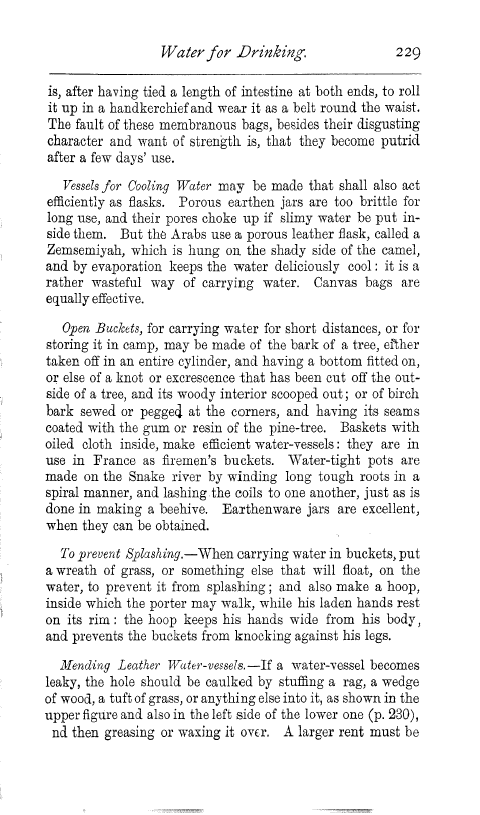Water for Drinking. 229
is, after having tied a length of intestine at both ends, to roll it up in a handkerchief and wear it as a belt round the waist. The fault of these membranous bags, besides their disgusting character and want of strength is, that they become putrid after a few days' use.
Vessels for Cooling Water may be made that shall also act efficiently as flasks. Porous earthen jars are too brittle for long use, and their pores choke up if slimy water be put inside them. But the Arabs use a porous leather flask, called a Zemsemiyah, which is hung on the shady side of the camel, and by evaporation keeps the water deliciously cool : it is a rather wasteful way of carrying water. Canvas bags are equally effective.
Open Buckets, for carrying water for short distances, or for storing it in camp, may be made of the bark of a tree, either taken off in an entire cylinder, and having a bottom fitted on, or else of a knot or excrescence that has been cut off the outside of a tree, and its woody interior scooped out ; or of birch bark sewed or pegged at the corners, and having its seams coated with the gum or resin of the pine-tree. Baskets with oiled cloth inside, make efficient water-vessels : they are in use in France as firemen's buckets. Water-tight pots are made on the Snake river by winding long tough roots in a spiral manner, and lashing the coils to one another, just as is done in making a beehive. Earthenware jars are excellent, when they can be obtained.
To prevent Splashing.-When carrying water in buckets, put a wreath of grass, or something else that will float, on the water, to prevent it from splashing ; and also make a hoop, inside which the porter may walk, while his laden hands rest on its rim : the hoop keeps his hands wide from his body, and prevents the buckets from knocking against his legs.
ill-ending Leather Water-vessels.-If a water-vessel becomes
leaky, the hole should be caulked by stuffing a rag, a wedge of wood, a tuft of grass, or anything else into it, as shown in the upper figure and also in the left side of the lower one (p. 230),
nd then greasing or waxing it ovEr. A larger rent must be

